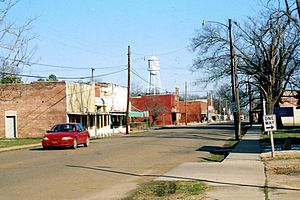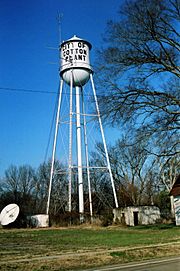Cotton Plant, Arkansas facts for kids
Quick facts for kids
Cotton Plant, Arkansas
|
|
|---|---|

Main Street, Cotton Plant, February 2007
|
|

Location of Cotton Plant in Woodruff County, Arkansas.
|
|
| Country | United States |
| State | Arkansas |
| County | Woodruff |
| Incorporated | November 14, 1887 |
| Government | |
| • Type | Mayor–council |
| Area | |
| • Total | 1.04 sq mi (2.69 km2) |
| • Land | 1.04 sq mi (2.69 km2) |
| • Water | 0.00 sq mi (0.00 km2) |
| Elevation | 194 ft (59 m) |
| Population
(2020)
|
|
| • Total | 529 |
| • Density | 509.14/sq mi (196.62/km2) |
| Time zone | UTC−06:00 (Central (CST)) |
| • Summer (DST) | UTC−05:00 (CDT) |
| ZIP Code |
72036
|
| Area code(s) | 870 |
| FIPS code | 05-15550 |
| GNIS feature ID | 0076683 |
Cotton Plant is a city in Woodruff County, Arkansas, United States. As of the 2010 census, the city had a total population of 649.
History

In 1820, when settlers from neighboring states first came to the Cotton Plant area, it was covered in dense timber and cane. As a small town began to take shape at the site of present-day Cotton Plant, those settlers initially gave their new community the name, Richmond.
William Lynch brought cotton seeds with him from Mississippi in 1846, and the new crop flourished. The community was forced to change its name to Cotton Plant since a community named Richmond was already registered in Little River County. On July 7, 1862, Confederate units and Cotton Plant locals skirmished with the 1st and 2nd Brigade, 1st Division, Army of the Southwest for the Union, a last-ditch effort by the Confederates to stop Samuel Curtis' march to Helena. The Confederates were soundly defeated, allowing Curtis and his army to eventually take Helena, resupply his army, and take Little Rock the following year.
A new line of the Brinkley and Batesville Railroad charged the Cotton Plant economy when it was completed in 1881. Warehouses, cotton gins, and a cotton compress brought jobs to the city, and downtown Cotton Plant became a bustling cultural center for Woodruff County. In 1908, the newly completed Missouri and North Arkansas Railroad opened up the timber industry about Cotton Plant, bringing the Standard Stave and Hoop Mill, sawmills, woodworking factories, and a veneer plant in subsequent years. Hit hard by the Great Depression, the Works Progress Administration was tasked with installing a water and sewer system in town in 1935. Residents celebrated with fireworks and parades upon the completion of the project. The community was also impacted by World War II, but boomed after the war, experiencing its most prosperous times in the 1950s.
Topography
According to the United States Census Bureau, the city has a total area of 1.0 square mile (2.6 km2), with no water bodies.
Demographics
| Historical population | |||
|---|---|---|---|
| Census | Pop. | %± | |
| 1880 | 98 | — | |
| 1890 | 429 | 337.8% | |
| 1900 | 458 | 6.8% | |
| 1910 | 1,081 | 136.0% | |
| 1920 | 1,661 | 53.7% | |
| 1930 | 1,689 | 1.7% | |
| 1940 | 1,778 | 5.3% | |
| 1950 | 1,838 | 3.4% | |
| 1960 | 1,704 | −7.3% | |
| 1970 | 1,657 | −2.8% | |
| 1980 | 1,323 | −20.2% | |
| 1990 | 1,150 | −13.1% | |
| 2000 | 960 | −16.5% | |
| 2010 | 649 | −32.4% | |
| 2020 | 529 | −18.5% | |
| U.S. Decennial Census | |||
2020 census
| Race | Num. | Perc. |
|---|---|---|
| White | 133 | 25.14% |
| Black or African American | 363 | 68.62% |
| Asian | 1 | 0.19% |
| Other/Mixed | 25 | 4.73% |
| Hispanic or Latino | 7 | 1.32% |
As of the 2020 United States Census, there were 529 people, 282 households, and 153 families residing in the city.
Education
Public education for early childhood, elementary and secondary school students is provided by the Augusta School District, which leads to graduation from Augusta High School.
On July 1, 2004, the Cotton Plant School District merged into the Augusta School District. Cotton Plant Elementary School remained as one of three schools in the district and served prekindergarten through grade 3. In 2014 the Augusta school district planned to close Cotton Plant Elementary and the Arkansas Department of Education (ADE) approved the closure.
Notable people
- Florence Price, famous composer
- Johnnie S. Aikens, Missouri state representative
- Jim McElroy, professional basketball player
- Pearl Peden Oldfield, first female from Arkansas elected to Congress
- Sister Rosetta Tharpe, gospel singer who began performing in local churches at the age of four
- Peetie Wheatstraw, blues singer with 166 recordings.
- Jesse Walter Arbor, one of the Golden Thirteen. Prior to 1945, there were no black officers in the U.S. Navy.

